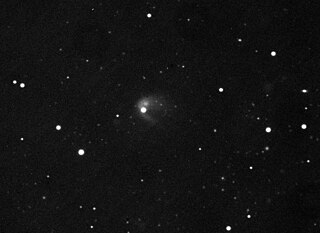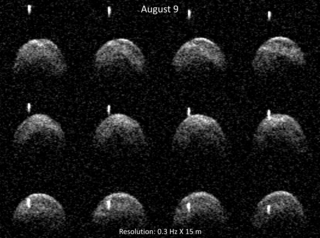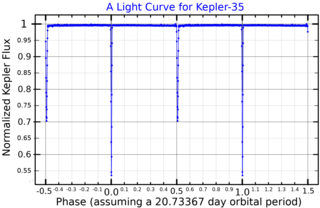Related Research Articles

A planet is a large, rounded astronomical body that is neither a star nor its remnant. The best available theory of planet formation is the nebular hypothesis, which posits that an interstellar cloud collapses out of a nebula to create a young protostar orbited by a protoplanetary disk. Planets grow in this disk by the gradual accumulation of material driven by gravity, a process called accretion. The Solar System has at least eight planets: the terrestrial planets Mercury, Venus, Earth, and Mars, and the giant planets Jupiter, Saturn, Uranus, and Neptune. These planets each rotate around an axis tilted with respect to its orbital pole. All the major planets of the Solar System other than Mercury possess a considerable atmosphere, and some share such features as ice caps, seasons, volcanism, hurricanes, tectonics, and even hydrology. Apart from Venus and Mars, the Solar System planets generate magnetic fields, and all the major planets except Venus and Mercury have natural satellites. The giant planets bear planetary rings, the most prominent being those of Saturn.

702 Alauda, provisional designation 1910 KQ, is a carbonaceous asteroid and binary system from the outer asteroid belt, approximately 190 kilometers in diameter. It is the parent body of the Alauda family. Discovered in 1910 by German astronomer Joseph Helffrich at Heidelberg Observatory, it was named after the lark (alauda). Its small moon, named Pichi üñëm, was discovered in 2007.

Active asteroids are small Solar System bodies that have asteroid-like orbits but show comet-like visual characteristics. That is, they show a coma, tail, or other visual evidence of mass-loss, but their orbits remain within Jupiter's orbit. These bodies were originally designated main-belt comets (MBCs) in 2006 by astronomers David Jewitt and Henry Hsieh, but this name implies they are necessarily icy in composition like a comet and that they only exist within the main-belt, whereas the growing population of active asteroids shows that this is not always the case.
This page describes exoplanet orbital and physical parameters.

A circumbinary planet is a planet that orbits two stars instead of one. The two stars orbit each other in a binary system, while the planet typically orbits farther from the center of the system than either of the two stars. In contrast, circumstellar planets in a binary system have stable orbits around one of the two stars, closer in than the orbital distance of the other star. Studies in 2013 showed that there is a strong hint that a circumbinary planet and its stars originate from a single disk.

Kepler-7b is one of the first five exoplanets to be confirmed by NASA's Kepler spacecraft, and was confirmed in the first 33.5 days of Kepler's science operations. It orbits a star slightly hotter and significantly larger than the Sun that is expected to soon reach the end of the main sequence. Kepler-7b is a hot Jupiter that is about half the mass of Jupiter, but is nearly 1.5 times its size; at the time of its discovery, Kepler-7b was the second most diffuse planet known, surpassed only by WASP-17b. It orbits its host star every five days at a distance of approximately 0,06 AU. Kepler-7b was announced at a meeting of the American Astronomical Society on January 4, 2010. It is the first extrasolar planet to have a crude map of cloud coverage.

(35107) 1991 VH is a binary near-Earth asteroid and potentially hazardous asteroid of the Apollo group. It was discovered on 9 November 1991, by Australian astronomer Robert McNaught at Siding Spring Observatory. This binary system is composed of a roughly-spheroidal primary body about one kilometre in diameter, and an elongated natural satellite less than half a kilometre in diameter. The 1991 VH system is unusual for its dynamically excited state; the satellite has a tumbling, non-synchronous rotation that chaotically exchanges energy and angular momentum with its precessing, eccentric orbit. This asteroid system was one of the two targets of NASA's upcoming Janus Mayhem mission, until the delay of the rocket launch made both targets inaccessible.

Kepler-35 is a binary star system in the constellation of Cygnus. These stars, called Kepler-35A and Kepler-35B have masses of 89% and 81% solar masses respectively, and both are assumed to be of spectral class G. They are separated by 0.176 AU, and complete an eccentric orbit around a common center of mass every 20.73 days.
Kepler-80, also known as KOI-500, is a red dwarf star of the spectral type M0V. This stellar classification places Kepler-80 among the very common, cool, class M stars that are still within their main evolutionary stage, known as the main sequence. Kepler-80, like other red dwarf stars, is smaller than the Sun, and it has both radius, mass, temperatures, and luminosity lower than that of our own star. Kepler-80 is found approximately 1,223 light years from the Solar System, in the stellar constellation Cygnus, also known as the Swan.
Dirk Terrell is an American astronomer and space artist who is the Director of the Computer and Software Sciences section in the Planetary Science Directorate of the Space Science and Engineering division of the Southwest Research Institute. He is a Fellow and former President of the International Association of Astronomical Artists. He holds a Bachelor of Science degree in physics from Clemson University and a Ph.D. in astrophysics from the University of Florida.

Kepler-25 is a star in the northern constellation of Lyra. It is slightly larger and more massive than the Sun, with a luminosity 21⁄2 times that of the Sun. With an apparent visual magnitude of 10.6, this star is too faint to be seen with the naked eye.
Kepler-13 or KOI-13 is a stellar triple star system consisting of Kepler-13A, around which an orbiting hot Jupiter exoplanet was discovered with the Kepler spacecraft in 2011, and Kepler-13B a common proper motion companion star which has an additional star orbiting it.

HD 179070, also known as Kepler-21, is a star with a closely orbiting exoplanet in the northern constellation of Lyra. At an apparent visual magnitude of 8.25 this was the brightest star observed by the Kepler spacecraft to host a validated planet until the discovery of an exoplanet orbiting HD 212657 in 2018. This system is located at a distance of 354 light-years from the Sun based on parallax measurements, but is drifting closer with a radial velocity of −18.2 km/s.
The small planet radius gap is an observed scarcity of planets with radii between 1.5 and 2 times Earth's radius, likely due to photoevaporation-driven mass loss. A bimodality in the Kepler exoplanet population was first observed in 2011 and attributed to the absence of significant gas atmospheres on close-in, low-mass planets. This feature was noted as possibly confirming an emerging hypothesis that photoevaporation could drive atmospheric mass loss This would lead to a population of bare, rocky cores with smaller radii at small separations from their parent stars, and planets with thick hydrogen- and helium-dominated envelopes with larger radii at larger separations. The bimodality in the distribution was confirmed with higher-precision data in the California-Kepler Survey in 2017, which was shown to match the predictions of the photoevaporative mass-loss hypothesis later that year.
Kepler-160 is a main-sequence star approximately the width of our Galactic arm away in the constellation Lyra, first studied in detail by the Kepler Mission, a NASA-led operation tasked with discovering terrestrial planets. The star, which is very similar to the Sun in mass and radius, has three confirmed planets and one unconfirmed planet orbiting it.
Kepler-410 is a binary star system. Its primary star, also known as Kepler-410A, is a F-type subgiant star, orbited by the orange dwarf star Kepler-410B on a wide orbit. The companion star was discovered in 2012.
References
- ↑ "Some Asteroids Have Astronomers Seeing Double". JPL press release. 11 April 2002. Archived from the original on 17 July 2012. Retrieved 10 November 2015.
- ↑ Margot, Jean-Luc; et al. (2002). "Binary Asteroids in the Near-Earth Object Population". Science. 296 (5572): 1445–1448. Bibcode:2002Sci...296.1445M. doi:10.1126/science.1072094. PMID 11951001. S2CID 8768432.
- ↑ "Prediction Proved: Light Speeds Up an Asteroid as it Spins". The New York Times. 13 March 2007.
- ↑ Taylor, Patrick; et al. (2007). "Spin Rate of Asteroid (54509) 2000 PH5 Increasing due to the YORP Effect". Science. 316 (5822): 274–277. Bibcode:2007Sci...316..274T. doi: 10.1126/science.1139038 . PMID 17347415. S2CID 29191700..
- ↑ Greenberg, Adam H.; Margot, Jean-Luc; Verma, Ashok K.; Taylor, Patrick A.; Hodge, Susan E. (7 February 2020). "Yarkovsky Drift Detections for 247 Near-Earth Asteroids". The Astronomical Journal. 159 (3): 92. arXiv: 1708.05513 . Bibcode:2020AJ....159...92G. doi: 10.3847/1538-3881/ab62a3 . S2CID 119502545.
- ↑ "Mercury's spin reveals molten, not solid core". Reuters. 3 May 2007.
- ↑ Margot, Jean-Luc; et al. (2007). "Large longitude libration of Mercury reveals a molten core". Science. 316 (5825): 710–714. Bibcode:2007Sci...316..710M. doi:10.1126/science.1140514. PMID 17478713. S2CID 8863681.
- ↑ Peale, S. J. (1976). "Does Mercury have a molten core?". Nature. 262 (5571): 765–766. Bibcode:1976Natur.262..765P. doi:10.1038/262765a0. S2CID 4210179.
- ↑ Margot, Jean-Luc; et al. (2012). "Mercury's moment of inertia from spin and gravity data". Journal of Geophysical Research. 117: n/a. Bibcode:2012JGRE..117.0L09M. doi: 10.1029/2012JE004161 .
- ↑ Fang, Julia; Margot, Jean-Luc (2012). "Architecture of Planetary Systems Based on Kepler Data: Number of Planets and Coplanarity". The Astrophysical Journal. 761 (2): 92. arXiv: 1207.5250 . Bibcode:2012ApJ...761...92F. doi:10.1088/0004-637X/761/2/92. ISSN 0004-637X. S2CID 20234144.
- ↑ "Most Alien Solar Systems Are 'Flatter Than Pancakes'". Space.com. 15 October 2012.
- ↑ Fang, Julia; Margot, Jean-Luc (2013). "Are Planetary Systems Filled to Capacity? A Study Based on Kepler Results". The Astrophysical Journal. 767 (2): 115. arXiv: 1302.7190 . Bibcode:2013ApJ...767..115F. doi:10.1088/0004-637X/767/2/115. ISSN 0004-637X. S2CID 53706876.
- ↑ "Why we need a new definition of the word 'planet'". Los Angeles Times. 14 November 2015.
- ↑ Margot, Jean-Luc (1 December 2015). "A Quantitative Criterion for Defining Planets". The Astronomical Journal. 150 (6): 185. arXiv: 1507.06300 . Bibcode:2015AJ....150..185M. doi:10.1088/0004-6256/150/6/185. S2CID 51684830.
- ↑ Crockett, Christopher. "How long is a day on Venus? Scientists crack mysteries of our closest neighbor". phys.org.
- ↑ Margot, Jean-Luc; Campbell, Donald B.; Giorgini, Jon D.; Jao, Joseph S.; Snedeker, Lawrence G.; Ghigo, Frank D.; Bonsall, Amber (July 2021). "Spin state and moment of inertia of Venus". Nature Astronomy. 5 (7): 676–683. arXiv: 2103.01504 . Bibcode:2021NatAs...5..676M. doi:10.1038/s41550-021-01339-7. S2CID 232092194.
- ↑ "Researchers Just Scanned 14 Worlds From the Kepler Mission for "Technosignatures", Evidence of Advanced Civilizations". Universe Today. 15 February 2018.
- ↑ Margot, Jean-Luc; Li, Megan G.; Pinchuk, Pavlo; Myhrvold, Nathan; Lesyna, Larry; et al. (1 November 2023). "A Search for Technosignatures Around 11,680 Stars with the Green Bank Telescope at 1.15–1.73 GHz". The Astronomical Journal. 166 (5): 206. arXiv: 2308.02712 . Bibcode:2023AJ....166..206M. doi: 10.3847/1538-3881/acfda4 .
- ↑ "UCLA is asking for the public's help in finding signs of extraterrestrial intelligence". Los Angeles Times. 15 February 2023.
- ↑ "Harold C. Urey Prize in Planetary Science". Division of Planetary Sciences of the American Astronomical Society . Retrieved 11 December 2021.
- ↑ "Small Body Orbital Elements 9531 Jean-Luc (1981 QK)". JPL. Retrieved 11 December 2021.